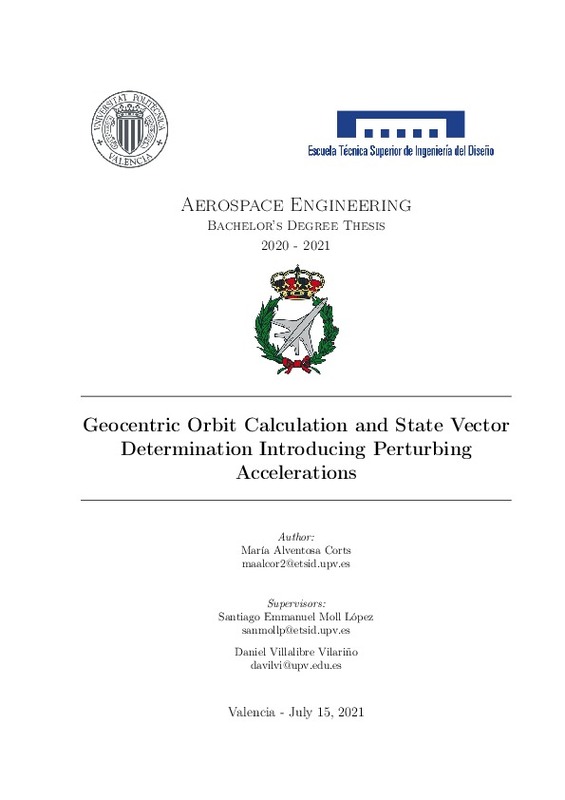|
Resumen:
|
[ES] La finalidad principal del presente proyecto es resolver la ecuación fundamental del movimiento relativo de dos cuerpos en el espacio, introduciendo un alto nivel de precisión, que se alcanza tomando en consideración ...[+]
[ES] La finalidad principal del presente proyecto es resolver la ecuación fundamental del movimiento relativo de dos cuerpos en el espacio, introduciendo un alto nivel de precisión, que se alcanza tomando en consideración las aceleraciones perturbadoras más relevantes al efectuar los cálculos. Haciendo uso de un robot matemático, en concreto MATLAB®, es posible integrar numéricamente la ecuación diferencial mediante el solver ode45. El resultado obtenido es el vector de estado del cuerpo secundario, que se encuentra orbitando alrededor del cuerpo principal.
A efectos de este trabajo, el caso de estudio relacionado con el problema de los dos cuerpos es el de un satélite en órbita alrededor de la Tierra, ofreciendo aproximaciones a dos casos reales. El análisis se lleva a cabo tanto para la ISS, un ejemplo de órbita LEO, como para el satélite LAGEOS-1, que se encuentra entre las órbitas LEO y Geoestacionarias. Las perturbaciones que van a ser implementadas a lo largo de este documento comprenden las aceleraciones gravitatorias debidas a los armónicos zonales, las fuerzas de rozamiento causadas por la atmósfera, o la gravedad de algunos cuerpos del Sistema Solar que influyen a la hora de determinar la órbita. Cabe mencionar que los efectos relativistas también se incluyen en los cálculos a modo de perturbaciones. A medida que éstas van siendo introducidas, se representan los errores de posición y velocidad con respecto a los vectores de estado reales en función del tiempo, de forma que se puede apreciar la evolución y mejora de los resultados con objeto de extraer conclusiones relevantes.
Por otra parte, se propone el diseño de una interfaz gráfica intuitiva que permita al usuario seleccionar de forma dinámica el tipo de satélite y el número de perturbaciones que se desee añadir al problema, para posteriormente poder visualizar la órbita calculada, así como sus parámetros orbitales y los gráficos del error en función del tiempo. Además, es posible introducir un impulso Delta-v al satélite con el fin de efectuar una maniobra orbital de cambio del apogeo o perigeo, o de cambio de plano de
la órbita.
[-]
[EN] The aim of this project is to solve the fundamental equation of relative motion between two bodies in space, introducing an increased level of accuracy, which is attained by considering the most relevant perturbing ...[+]
[EN] The aim of this project is to solve the fundamental equation of relative motion between two bodies in space, introducing an increased level of accuracy, which is attained by considering the most relevant perturbing accelerations when performing the calculations. Making use of a mathematical robot, namely MATLAB®, it is possible to numerically integrate the differential equation by means of solver ode45. The result obtained is the state vector of the secondary body, which is found orbiting around the main one.
For the purpose of this paper, the case under study for the two-body problem is that of a satellite in orbit around the Earth, offering an approach to two different real cases. The analysis is carried out for both the ISS, an example of Low Earth Orbit, and for LAGEOS-1, which is found between LEO and Geostationary orbits. The perturbations which are to be implemented along this document comprise the gravitational accelerations due to the Earth¿s zonal harmonics, the drag forces caused by the atmosphere, or the gravity of several bodies in the Solar System which influence the orbit determination as well. It is worth mentioning that relativistic effects are also accounted for in the calculations. As perturbations are introduced, the position and velocity errors with respect to the real state vectors are plotted as a function of time, so that the evolution and improvement of the results can be appreciated, and some relevant conclusions can be extracted.
Furthermore, a graphical, user-friendly interface is designed in order to dynamically select the satellite type as well as the perturbations to be added to the problem, and clearly visualize the orbit, its parameters and the state vector error. In addition, it allows to provide a Delta-v impulse so as to perform an orbital maneuver in order to make a change either in the apogee or perigee location, or in the orbit plane.
[-]
|







